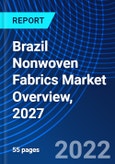10% Free customization
Nonwovens are not made by weaving or knitting and do not require converting the fibres to yarn. Nonwoven Fabricss are engineered Fabricss that may be single-use disposable or very durable Fabricss. They are used in numerous applications, including baby diapers, adult incontinence products, wet wipes, surgical drapes and covers, liquid cartridge and bag filters, face masks, air-conditioning filters, soil stabilisers and roadway underlayment, erosion control, drainage systems, insulation (fiberglass batting), pillows, cushions, and upholstery padding, carpet backing, automotive headliners and upholstery, house wraps, and disposable clothing (foot coverings, coveralls). Non-woven Fabricss could broadly be defined as sheet or web structures bonded together by entangling fibres or filaments and also perforated films. This is done mechanically, thermally, or chemically. These Fabricss are lighter and weaker than woven or knit Fabricss. They don’t have much memory (for example, if you bend your elbow, the Fabrics will retain that position and leave a pucker in the Fabrics) or laundering durability, making them unsuitable in durable clothing applications. Since they are cheap to produce, they’re ideal for single-use products such as wipes, medical products, feminine hygiene products, disposable diapers, etc.This report comes with 10% free customization, enabling you to add data that meets your specific business needs.
1h Free Analyst TimeSpeak directly to the analyst to clarify any post sales queries you may have.
According to the research report Canada Nonwoven Fabrics Market Overview, 2027 it is expected to grow, but at a very slow pace over the forecast period. The most common polymer type is polypropylene, but polyester, biopolymers, and natural fibres are expected to drive future nonwoven Fabrics demand. Single-layer nonwoven Fabricss are in great demand. Spun bond and dry-laid technologies are mostly used to produce nonwoven Fabrics. Hygiene, building and construction, and medical industries have large-scale applications.
Polypropylene is the most widely used nonwoven Fabrics as it is a lightweight synthetic material that is inexpensive, durable, breathable, water resistant, and recyclable, as a result of which it is the most widely used nonwoven Fabrics. PP is generally considered non-toxic and the safest for human contact. PP is used in a broad range of applications and is available in many forms. Nonwoven polypropylene is used in masks because it is nontoxic, breathable, hydrophobic (water-resistant), lightweight, provides filtration, and is inexpensive. Hence, polypropylene nonwoven Fabrics has large-scale application in various industries.
Spun bond technology is generally used to make nonwoven Fabricss. Nonwoven Fabricss are made up of the continuous process of fibres spun and directly dispersed into a web-like deflector or can be directed with air streams. This process leads to a faster belt speed. Basically, these are prepared in a sheet or web structure bonded by entangled fibres or filaments by thermal or chemical treatments, as required by the spun bond Fabrics supplier or spun bond Fabrics manufacturer. It is made of low linear density polyethylene with a high branching ratio; it has good flexibility, water permeability, resistance, softness, and low-temperature resistance; and it also has features like being water-resistant or waterproof. Spun bond nonwoven Fabrics if made biodegradable, the raw materials would be twice as costly.
Nonwoven Fabricss are highly used in hygiene products as they have excellent absorption, softness, smoothness, stretchability, comfort and fit, strength, lotions can be added for specific uses, and good uniformity. Users of absorbent hygiene products benefit from the softness, smoothness, leakage prevention, strength and protection provided by nonwovens. Nonwovens are used in baby diapers, feminine hygiene, adult incontinence, and personal care products. They are used in multiple elements of the products. such as top sheet or cover stock, leg cuff, acquisition/distribution layer, core wrap, back sheet, stretch ears, landing zone, dusting layer, and fastening systems.
Considered in this report:
- Geography: Canada
- Base year: 2021
- Estimated year: 2022
- Forecast year: 2027
Aspects covered in this report
- Canada Nonwoven Fabrics market with its value & volume and forecast along with its segments
- Various drivers and challenges
- On-going trends and developments
- Top profiled companies
- Strategic recommendation
By Polymer Type in the report:
- Polypropylene
- Polyethylene
- PET
- Wood pulp
- Rayon
- Others (PA, PC, polyester, natural fibres, biopolymers)
By Layer Type in the report:
- Single-layer
- Multilayer
By Technologies in the report:
- Spun bond
- Wet laid
- Dry laid
- Others (electrostatic spinning and flash-spun)
By Application in the report:
- Hygiene
- Medical
- Filtration
- Automotive
- Building & Construction
- Others
The approach of the report:
This report consists of a combined approach of primary as well as secondary research. Initially, secondary research was used to get an understanding of the market and listing out the companies that are present in the market. The secondary research consists of third party sources such as press releases, annual report of companies, analysing the government generated reports and databases. After gathering the data from secondary sources primary research was conducted by making telephonic interviews with the leading players about how the market is functioning and then conducted trade calls with dealers and distributors of the market. Post this we have started doing primary calls to consumers by equally segmenting consumers in regional aspects, tier aspects, age group, and gender. Once we have primary data with us we have started verifying the details obtained from secondary sources.Intended audience
This report can be useful to industry consultants, manufacturers, suppliers, associations & organizations related to Nonwoven Fabrics Industry, government bodies and other stakeholders to align their market-centric strategies. In addition to marketing & presentations, it will also increase competitive knowledge about the industry.Table of Contents
1. Executive Summary3. Canada Macro Economic Indicators5. Canada Nonwoven Fabrics Market Trends10. Strategic Recommendations11. Disclaimer
2. Introduction
4. Canada Nonwoven Fabrics Market Category Analysis
6. Canada Nonwoven Fabrics Market Overview
7. Canada Nonwoven Fabrics Market Segmentations
8. Canada Nonwoven Fabrics Market Opportunity Assessment
9. Competitive Landscape
List of Figures
List of Table








